Capital Budgeting Process: Analyzing Valley University Bus Project
VerifiedAdded on 2023/01/09
|11
|2578
|49
Case Study
AI Summary
This case study examines Valley University's consideration of a dedicated bus service for staff and students, prompting an inquiry to the municipal bus service (MARTS). The analysis employs capital budgeting techniques, including discounted cash flow (DCF) and net present value (NPV), to evaluate the financial viability of the project. Key factors such as capital fund accessibility, rate of return, future earnings, profit estimation, and cash inflows are considered. The critical review and evaluation of the bus service investment include a cost analysis, revenue projections, and recommendations for improving profitability, such as adjusting fare charges and managing driver compensation. The study concludes with an internal rate of return of 25%, a net present value of $2,456, and a payback period of 4 years.
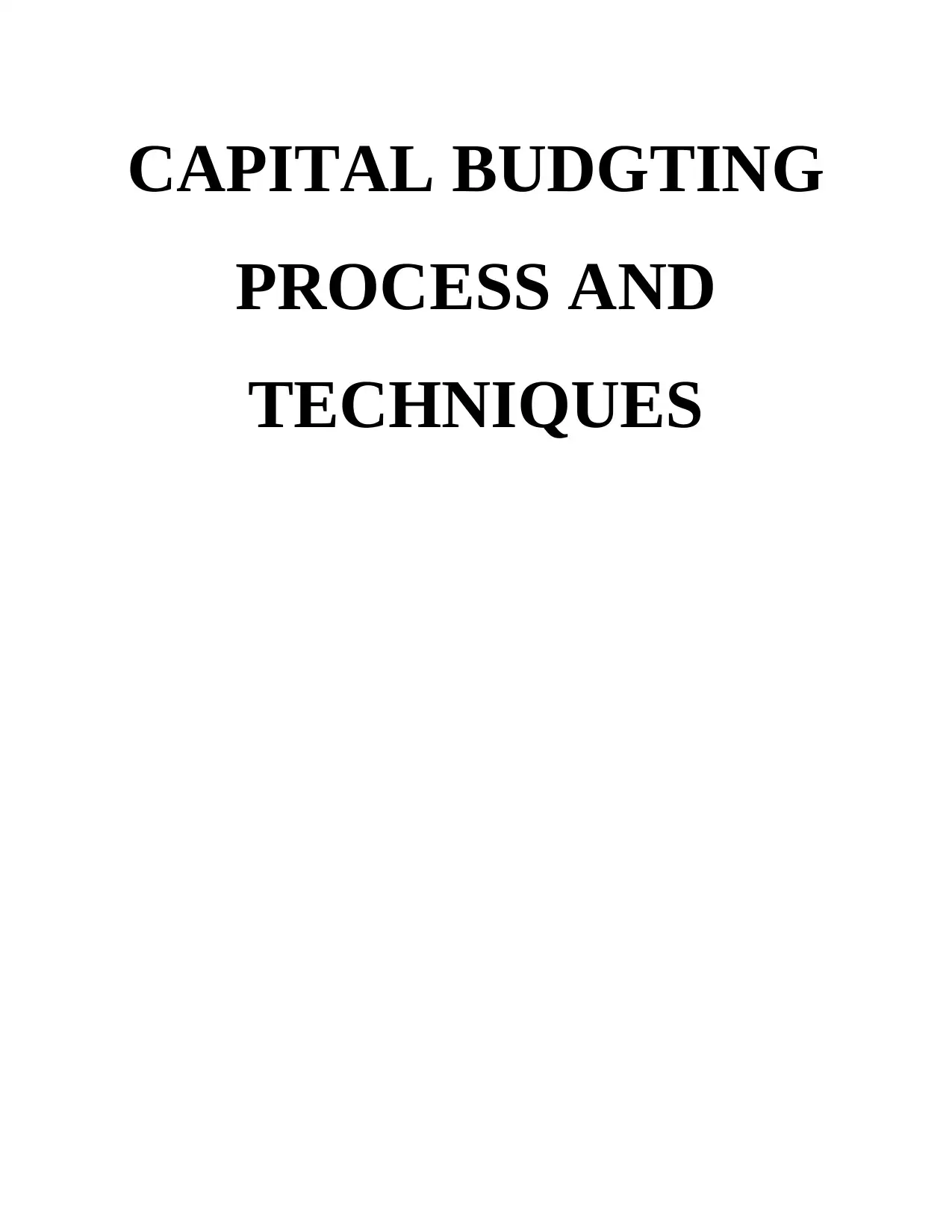
CAPITAL BUDGTING
PROCESS AND
TECHNIQUES
PROCESS AND
TECHNIQUES
Paraphrase This Document
Need a fresh take? Get an instant paraphrase of this document with our AI Paraphraser
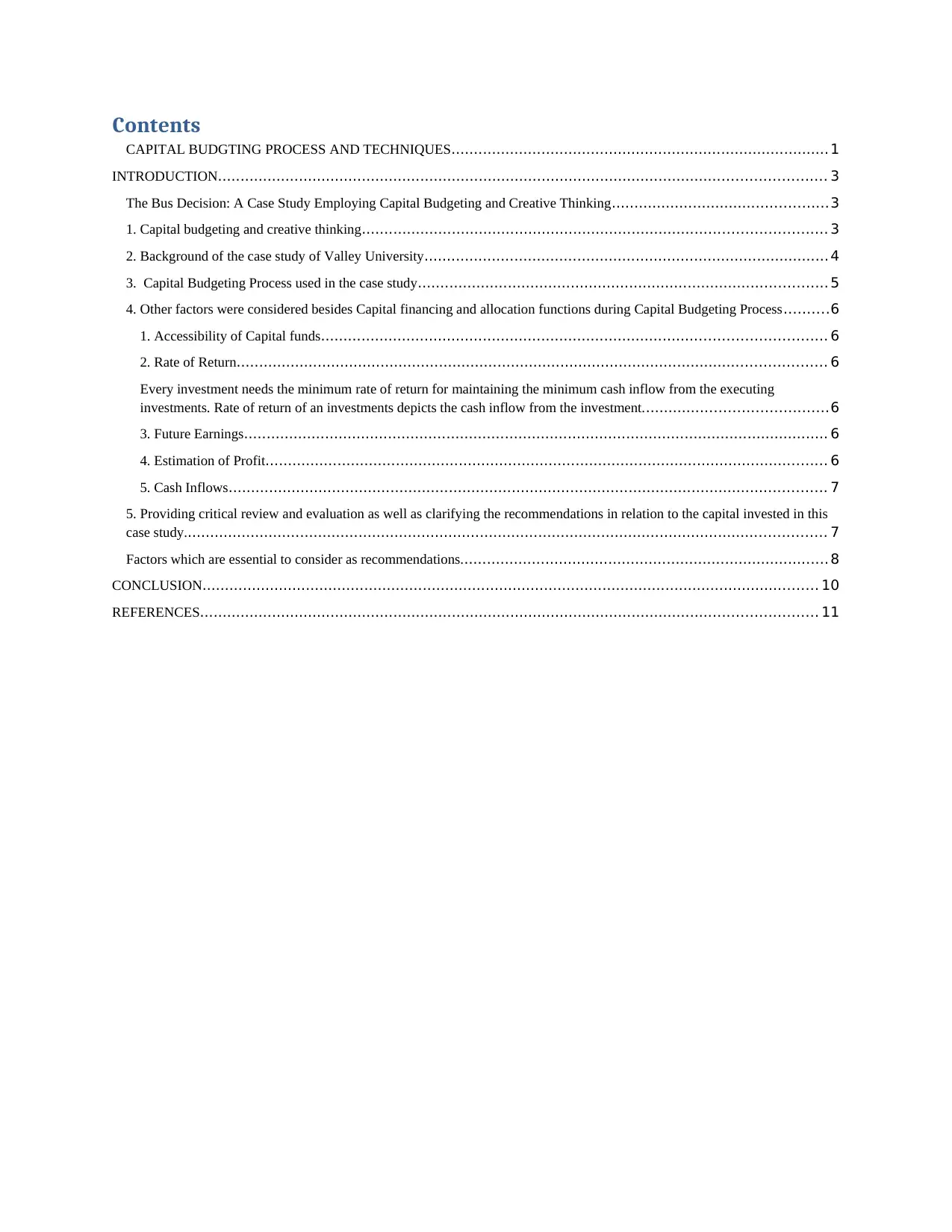
Contents
CAPITAL BUDGTING PROCESS AND TECHNIQUES.................................................................................... 1
INTRODUCTION....................................................................................................................................... 3
The Bus Decision: A Case Study Employing Capital Budgeting and Creative Thinking................................................3
1. Capital budgeting and creative thinking....................................................................................................... 3
2. Background of the case study of Valley University.......................................................................................... 4
3. Capital Budgeting Process used in the case study........................................................................................... 5
4. Other factors were considered besides Capital financing and allocation functions during Capital Budgeting Process..........6
1. Accessibility of Capital funds................................................................................................................ 6
2. Rate of Return................................................................................................................................... 6
Every investment needs the minimum rate of return for maintaining the minimum cash inflow from the executing
investments. Rate of return of an investments depicts the cash inflow from the investment.........................................6
3. Future Earnings.................................................................................................................................. 6
4. Estimation of Profit............................................................................................................................. 6
5. Cash Inflows..................................................................................................................................... 7
5. Providing critical review and evaluation as well as clarifying the recommendations in relation to the capital invested in this
case study............................................................................................................................................... 7
Factors which are essential to consider as recommendations.................................................................................. 8
CONCLUSION......................................................................................................................................... 10
REFERENCES......................................................................................................................................... 11
CAPITAL BUDGTING PROCESS AND TECHNIQUES.................................................................................... 1
INTRODUCTION....................................................................................................................................... 3
The Bus Decision: A Case Study Employing Capital Budgeting and Creative Thinking................................................3
1. Capital budgeting and creative thinking....................................................................................................... 3
2. Background of the case study of Valley University.......................................................................................... 4
3. Capital Budgeting Process used in the case study........................................................................................... 5
4. Other factors were considered besides Capital financing and allocation functions during Capital Budgeting Process..........6
1. Accessibility of Capital funds................................................................................................................ 6
2. Rate of Return................................................................................................................................... 6
Every investment needs the minimum rate of return for maintaining the minimum cash inflow from the executing
investments. Rate of return of an investments depicts the cash inflow from the investment.........................................6
3. Future Earnings.................................................................................................................................. 6
4. Estimation of Profit............................................................................................................................. 6
5. Cash Inflows..................................................................................................................................... 7
5. Providing critical review and evaluation as well as clarifying the recommendations in relation to the capital invested in this
case study............................................................................................................................................... 7
Factors which are essential to consider as recommendations.................................................................................. 8
CONCLUSION......................................................................................................................................... 10
REFERENCES......................................................................................................................................... 11

⊘ This is a preview!⊘
Do you want full access?
Subscribe today to unlock all pages.

Trusted by 1+ million students worldwide
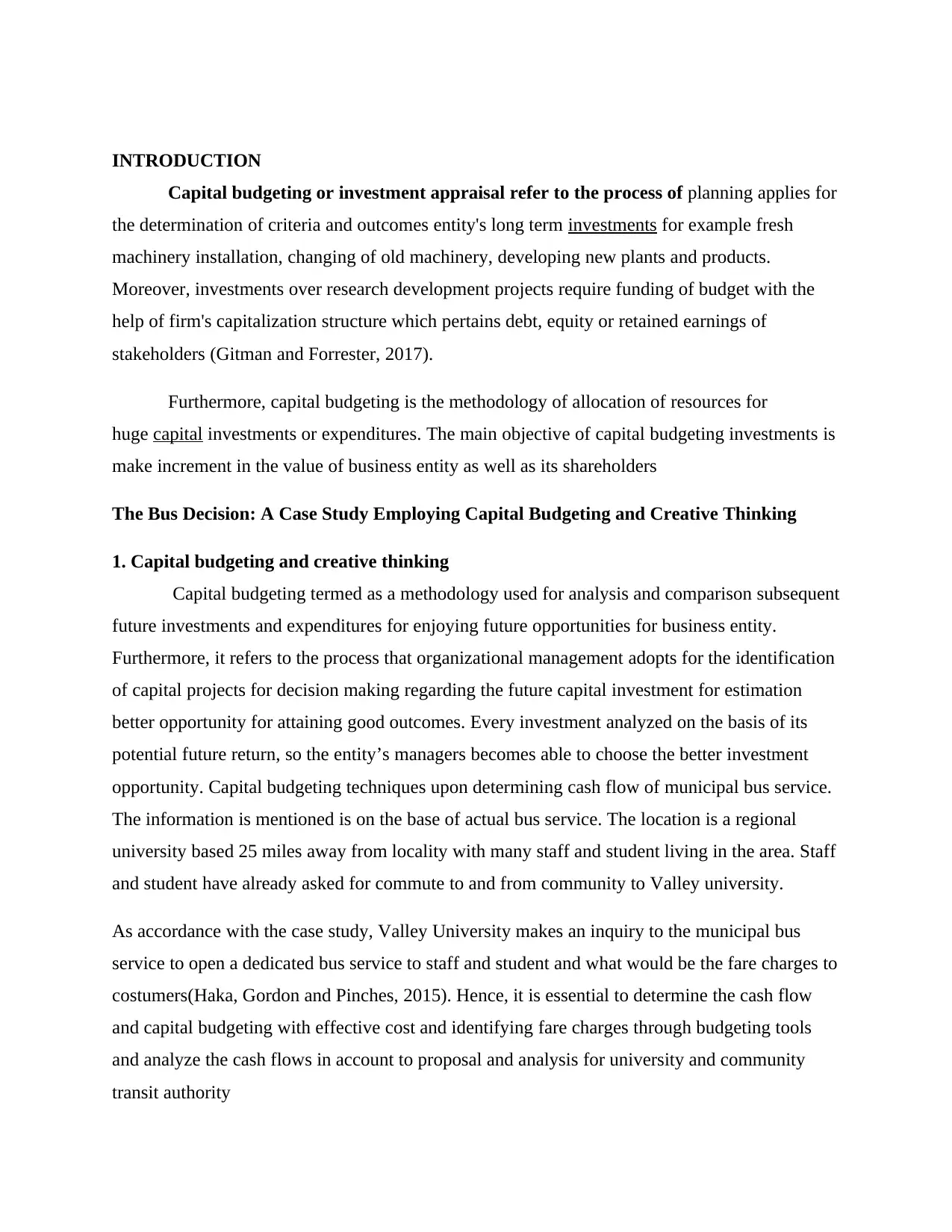
INTRODUCTION
Capital budgeting or investment appraisal refer to the process of planning applies for
the determination of criteria and outcomes entity's long term investments for example fresh
machinery installation, changing of old machinery, developing new plants and products.
Moreover, investments over research development projects require funding of budget with the
help of firm's capitalization structure which pertains debt, equity or retained earnings of
stakeholders (Gitman and Forrester, 2017).
Furthermore, capital budgeting is the methodology of allocation of resources for
huge capital investments or expenditures. The main objective of capital budgeting investments is
make increment in the value of business entity as well as its shareholders
The Bus Decision: A Case Study Employing Capital Budgeting and Creative Thinking
1. Capital budgeting and creative thinking
Capital budgeting termed as a methodology used for analysis and comparison subsequent
future investments and expenditures for enjoying future opportunities for business entity.
Furthermore, it refers to the process that organizational management adopts for the identification
of capital projects for decision making regarding the future capital investment for estimation
better opportunity for attaining good outcomes. Every investment analyzed on the basis of its
potential future return, so the entity’s managers becomes able to choose the better investment
opportunity. Capital budgeting techniques upon determining cash flow of municipal bus service.
The information is mentioned is on the base of actual bus service. The location is a regional
university based 25 miles away from locality with many staff and student living in the area. Staff
and student have already asked for commute to and from community to Valley university.
As accordance with the case study, Valley University makes an inquiry to the municipal bus
service to open a dedicated bus service to staff and student and what would be the fare charges to
costumers(Haka, Gordon and Pinches, 2015). Hence, it is essential to determine the cash flow
and capital budgeting with effective cost and identifying fare charges through budgeting tools
and analyze the cash flows in account to proposal and analysis for university and community
transit authority
Capital budgeting or investment appraisal refer to the process of planning applies for
the determination of criteria and outcomes entity's long term investments for example fresh
machinery installation, changing of old machinery, developing new plants and products.
Moreover, investments over research development projects require funding of budget with the
help of firm's capitalization structure which pertains debt, equity or retained earnings of
stakeholders (Gitman and Forrester, 2017).
Furthermore, capital budgeting is the methodology of allocation of resources for
huge capital investments or expenditures. The main objective of capital budgeting investments is
make increment in the value of business entity as well as its shareholders
The Bus Decision: A Case Study Employing Capital Budgeting and Creative Thinking
1. Capital budgeting and creative thinking
Capital budgeting termed as a methodology used for analysis and comparison subsequent
future investments and expenditures for enjoying future opportunities for business entity.
Furthermore, it refers to the process that organizational management adopts for the identification
of capital projects for decision making regarding the future capital investment for estimation
better opportunity for attaining good outcomes. Every investment analyzed on the basis of its
potential future return, so the entity’s managers becomes able to choose the better investment
opportunity. Capital budgeting techniques upon determining cash flow of municipal bus service.
The information is mentioned is on the base of actual bus service. The location is a regional
university based 25 miles away from locality with many staff and student living in the area. Staff
and student have already asked for commute to and from community to Valley university.
As accordance with the case study, Valley University makes an inquiry to the municipal bus
service to open a dedicated bus service to staff and student and what would be the fare charges to
costumers(Haka, Gordon and Pinches, 2015). Hence, it is essential to determine the cash flow
and capital budgeting with effective cost and identifying fare charges through budgeting tools
and analyze the cash flows in account to proposal and analysis for university and community
transit authority
Paraphrase This Document
Need a fresh take? Get an instant paraphrase of this document with our AI Paraphraser
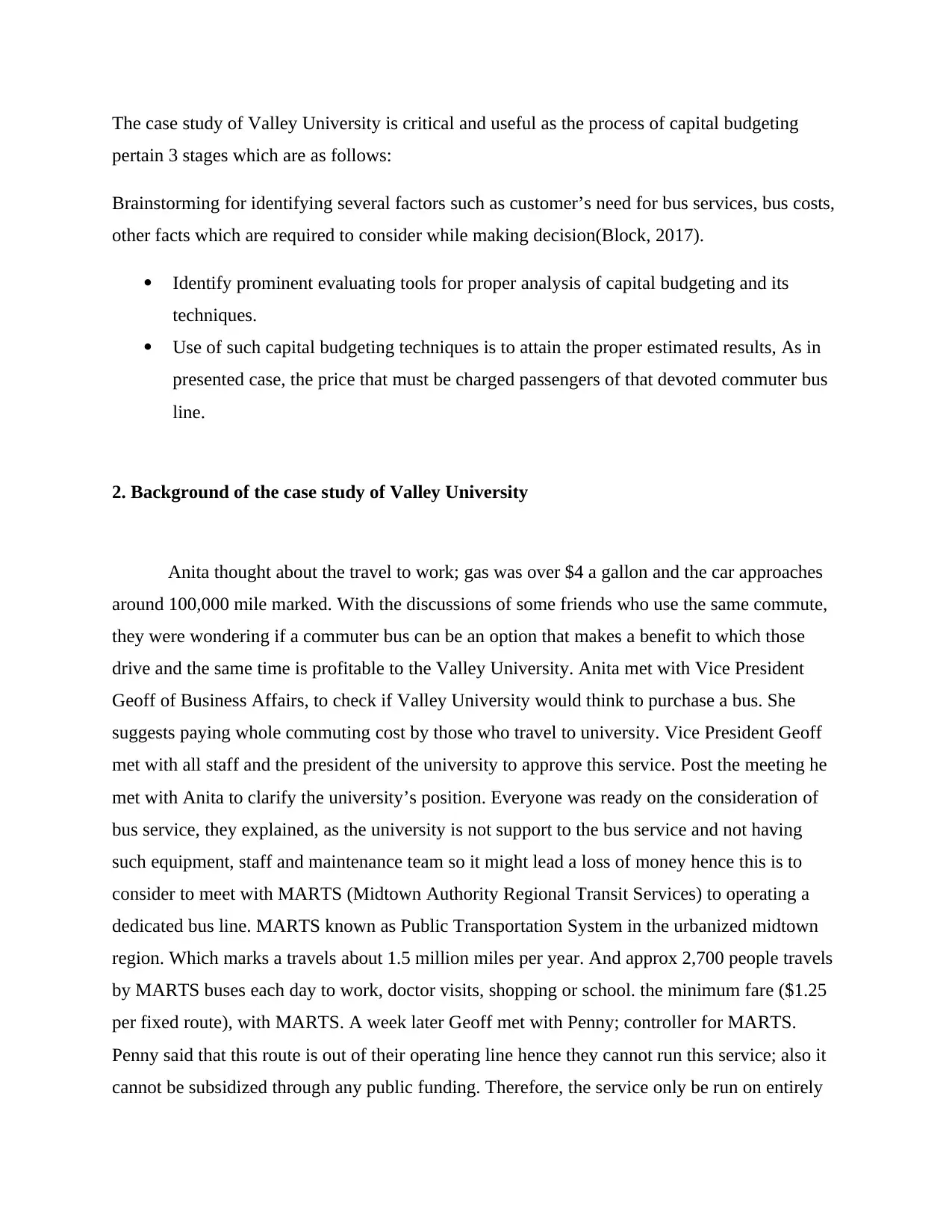
The case study of Valley University is critical and useful as the process of capital budgeting
pertain 3 stages which are as follows:
Brainstorming for identifying several factors such as customer’s need for bus services, bus costs,
other facts which are required to consider while making decision(Block, 2017).
Identify prominent evaluating tools for proper analysis of capital budgeting and its
techniques.
Use of such capital budgeting techniques is to attain the proper estimated results, As in
presented case, the price that must be charged passengers of that devoted commuter bus
line.
2. Background of the case study of Valley University
Anita thought about the travel to work; gas was over $4 a gallon and the car approaches
around 100,000 mile marked. With the discussions of some friends who use the same commute,
they were wondering if a commuter bus can be an option that makes a benefit to which those
drive and the same time is profitable to the Valley University. Anita met with Vice President
Geoff of Business Affairs, to check if Valley University would think to purchase a bus. She
suggests paying whole commuting cost by those who travel to university. Vice President Geoff
met with all staff and the president of the university to approve this service. Post the meeting he
met with Anita to clarify the university’s position. Everyone was ready on the consideration of
bus service, they explained, as the university is not support to the bus service and not having
such equipment, staff and maintenance team so it might lead a loss of money hence this is to
consider to meet with MARTS (Midtown Authority Regional Transit Services) to operating a
dedicated bus line. MARTS known as Public Transportation System in the urbanized midtown
region. Which marks a travels about 1.5 million miles per year. And approx 2,700 people travels
by MARTS buses each day to work, doctor visits, shopping or school. the minimum fare ($1.25
per fixed route), with MARTS. A week later Geoff met with Penny; controller for MARTS.
Penny said that this route is out of their operating line hence they cannot run this service; also it
cannot be subsidized through any public funding. Therefore, the service only be run on entirely
pertain 3 stages which are as follows:
Brainstorming for identifying several factors such as customer’s need for bus services, bus costs,
other facts which are required to consider while making decision(Block, 2017).
Identify prominent evaluating tools for proper analysis of capital budgeting and its
techniques.
Use of such capital budgeting techniques is to attain the proper estimated results, As in
presented case, the price that must be charged passengers of that devoted commuter bus
line.
2. Background of the case study of Valley University
Anita thought about the travel to work; gas was over $4 a gallon and the car approaches
around 100,000 mile marked. With the discussions of some friends who use the same commute,
they were wondering if a commuter bus can be an option that makes a benefit to which those
drive and the same time is profitable to the Valley University. Anita met with Vice President
Geoff of Business Affairs, to check if Valley University would think to purchase a bus. She
suggests paying whole commuting cost by those who travel to university. Vice President Geoff
met with all staff and the president of the university to approve this service. Post the meeting he
met with Anita to clarify the university’s position. Everyone was ready on the consideration of
bus service, they explained, as the university is not support to the bus service and not having
such equipment, staff and maintenance team so it might lead a loss of money hence this is to
consider to meet with MARTS (Midtown Authority Regional Transit Services) to operating a
dedicated bus line. MARTS known as Public Transportation System in the urbanized midtown
region. Which marks a travels about 1.5 million miles per year. And approx 2,700 people travels
by MARTS buses each day to work, doctor visits, shopping or school. the minimum fare ($1.25
per fixed route), with MARTS. A week later Geoff met with Penny; controller for MARTS.
Penny said that this route is out of their operating line hence they cannot run this service; also it
cannot be subsidized through any public funding. Therefore, the service only be run on entirely
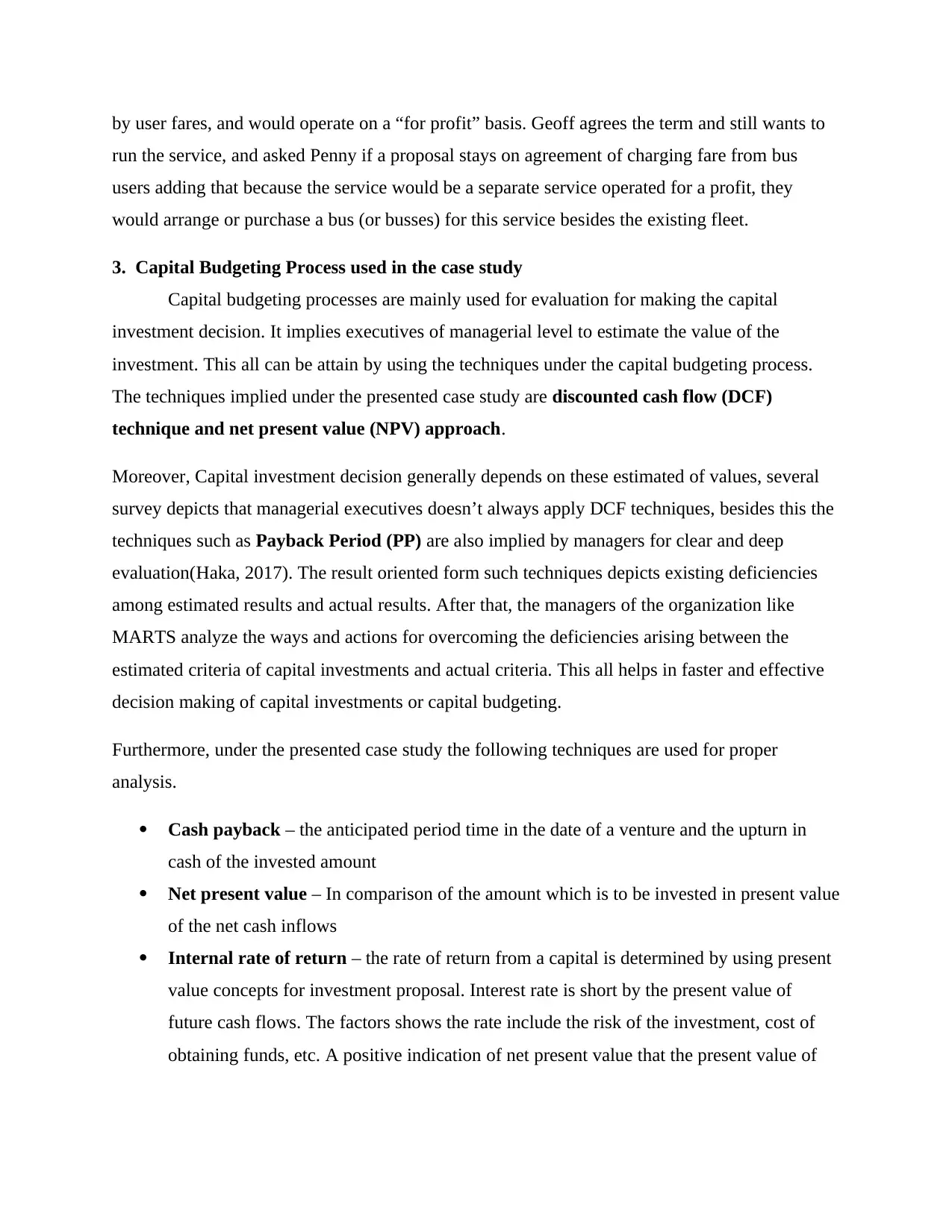
by user fares, and would operate on a “for profit” basis. Geoff agrees the term and still wants to
run the service, and asked Penny if a proposal stays on agreement of charging fare from bus
users adding that because the service would be a separate service operated for a profit, they
would arrange or purchase a bus (or busses) for this service besides the existing fleet.
3. Capital Budgeting Process used in the case study
Capital budgeting processes are mainly used for evaluation for making the capital
investment decision. It implies executives of managerial level to estimate the value of the
investment. This all can be attain by using the techniques under the capital budgeting process.
The techniques implied under the presented case study are discounted cash flow (DCF)
technique and net present value (NPV) approach.
Moreover, Capital investment decision generally depends on these estimated of values, several
survey depicts that managerial executives doesn’t always apply DCF techniques, besides this the
techniques such as Payback Period (PP) are also implied by managers for clear and deep
evaluation(Haka, 2017). The result oriented form such techniques depicts existing deficiencies
among estimated results and actual results. After that, the managers of the organization like
MARTS analyze the ways and actions for overcoming the deficiencies arising between the
estimated criteria of capital investments and actual criteria. This all helps in faster and effective
decision making of capital investments or capital budgeting.
Furthermore, under the presented case study the following techniques are used for proper
analysis.
Cash payback – the anticipated period time in the date of a venture and the upturn in
cash of the invested amount
Net present value – In comparison of the amount which is to be invested in present value
of the net cash inflows
Internal rate of return – the rate of return from a capital is determined by using present
value concepts for investment proposal. Interest rate is short by the present value of
future cash flows. The factors shows the rate include the risk of the investment, cost of
obtaining funds, etc. A positive indication of net present value that the present value of
run the service, and asked Penny if a proposal stays on agreement of charging fare from bus
users adding that because the service would be a separate service operated for a profit, they
would arrange or purchase a bus (or busses) for this service besides the existing fleet.
3. Capital Budgeting Process used in the case study
Capital budgeting processes are mainly used for evaluation for making the capital
investment decision. It implies executives of managerial level to estimate the value of the
investment. This all can be attain by using the techniques under the capital budgeting process.
The techniques implied under the presented case study are discounted cash flow (DCF)
technique and net present value (NPV) approach.
Moreover, Capital investment decision generally depends on these estimated of values, several
survey depicts that managerial executives doesn’t always apply DCF techniques, besides this the
techniques such as Payback Period (PP) are also implied by managers for clear and deep
evaluation(Haka, 2017). The result oriented form such techniques depicts existing deficiencies
among estimated results and actual results. After that, the managers of the organization like
MARTS analyze the ways and actions for overcoming the deficiencies arising between the
estimated criteria of capital investments and actual criteria. This all helps in faster and effective
decision making of capital investments or capital budgeting.
Furthermore, under the presented case study the following techniques are used for proper
analysis.
Cash payback – the anticipated period time in the date of a venture and the upturn in
cash of the invested amount
Net present value – In comparison of the amount which is to be invested in present value
of the net cash inflows
Internal rate of return – the rate of return from a capital is determined by using present
value concepts for investment proposal. Interest rate is short by the present value of
future cash flows. The factors shows the rate include the risk of the investment, cost of
obtaining funds, etc. A positive indication of net present value that the present value of
⊘ This is a preview!⊘
Do you want full access?
Subscribe today to unlock all pages.

Trusted by 1+ million students worldwide
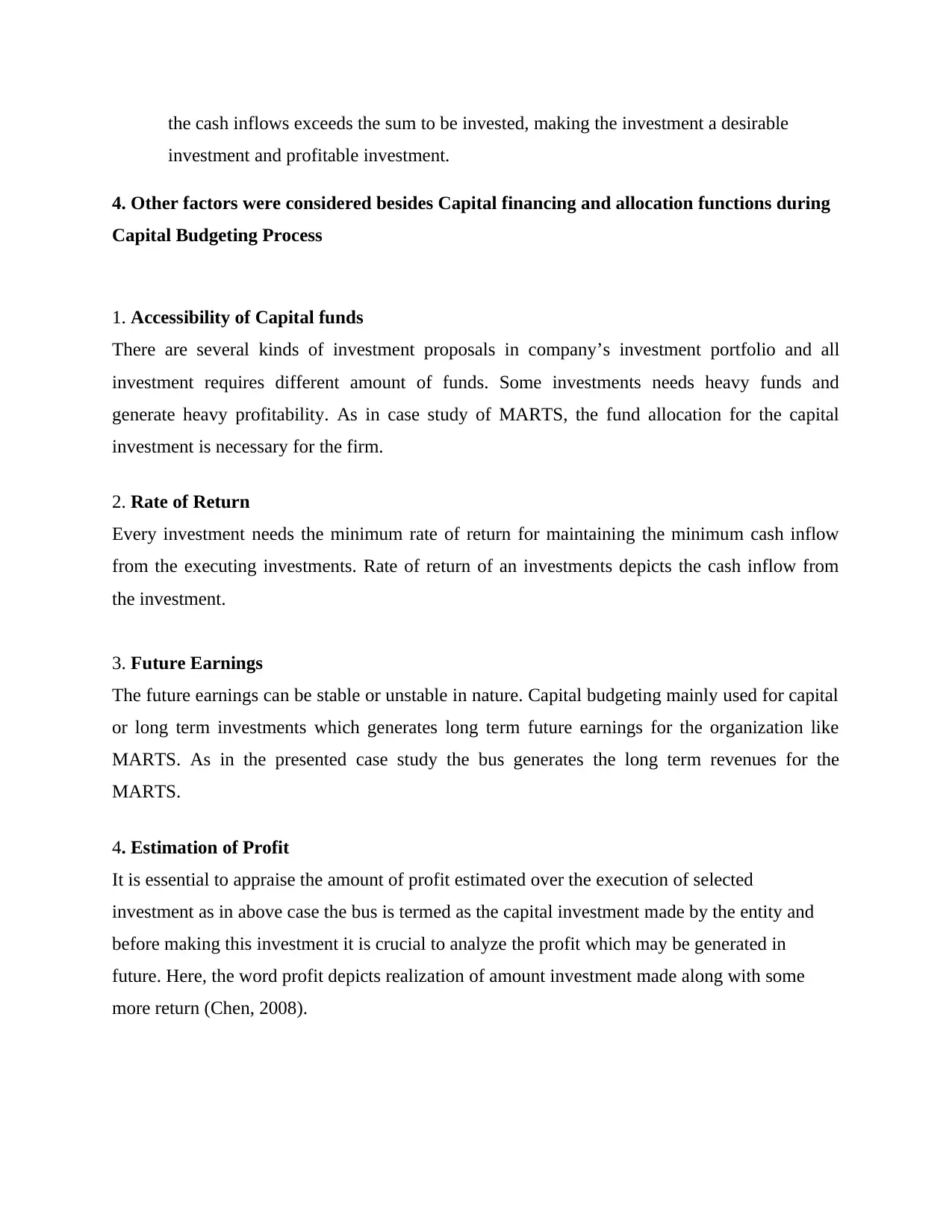
the cash inflows exceeds the sum to be invested, making the investment a desirable
investment and profitable investment.
4. Other factors were considered besides Capital financing and allocation functions during
Capital Budgeting Process
1. Accessibility of Capital funds
There are several kinds of investment proposals in company’s investment portfolio and all
investment requires different amount of funds. Some investments needs heavy funds and
generate heavy profitability. As in case study of MARTS, the fund allocation for the capital
investment is necessary for the firm.
2. Rate of Return
Every investment needs the minimum rate of return for maintaining the minimum cash inflow
from the executing investments. Rate of return of an investments depicts the cash inflow from
the investment.
3. Future Earnings
The future earnings can be stable or unstable in nature. Capital budgeting mainly used for capital
or long term investments which generates long term future earnings for the organization like
MARTS. As in the presented case study the bus generates the long term revenues for the
MARTS.
4. Estimation of Profit
It is essential to appraise the amount of profit estimated over the execution of selected
investment as in above case the bus is termed as the capital investment made by the entity and
before making this investment it is crucial to analyze the profit which may be generated in
future. Here, the word profit depicts realization of amount investment made along with some
more return (Chen, 2008).
investment and profitable investment.
4. Other factors were considered besides Capital financing and allocation functions during
Capital Budgeting Process
1. Accessibility of Capital funds
There are several kinds of investment proposals in company’s investment portfolio and all
investment requires different amount of funds. Some investments needs heavy funds and
generate heavy profitability. As in case study of MARTS, the fund allocation for the capital
investment is necessary for the firm.
2. Rate of Return
Every investment needs the minimum rate of return for maintaining the minimum cash inflow
from the executing investments. Rate of return of an investments depicts the cash inflow from
the investment.
3. Future Earnings
The future earnings can be stable or unstable in nature. Capital budgeting mainly used for capital
or long term investments which generates long term future earnings for the organization like
MARTS. As in the presented case study the bus generates the long term revenues for the
MARTS.
4. Estimation of Profit
It is essential to appraise the amount of profit estimated over the execution of selected
investment as in above case the bus is termed as the capital investment made by the entity and
before making this investment it is crucial to analyze the profit which may be generated in
future. Here, the word profit depicts realization of amount investment made along with some
more return (Chen, 2008).
Paraphrase This Document
Need a fresh take? Get an instant paraphrase of this document with our AI Paraphraser
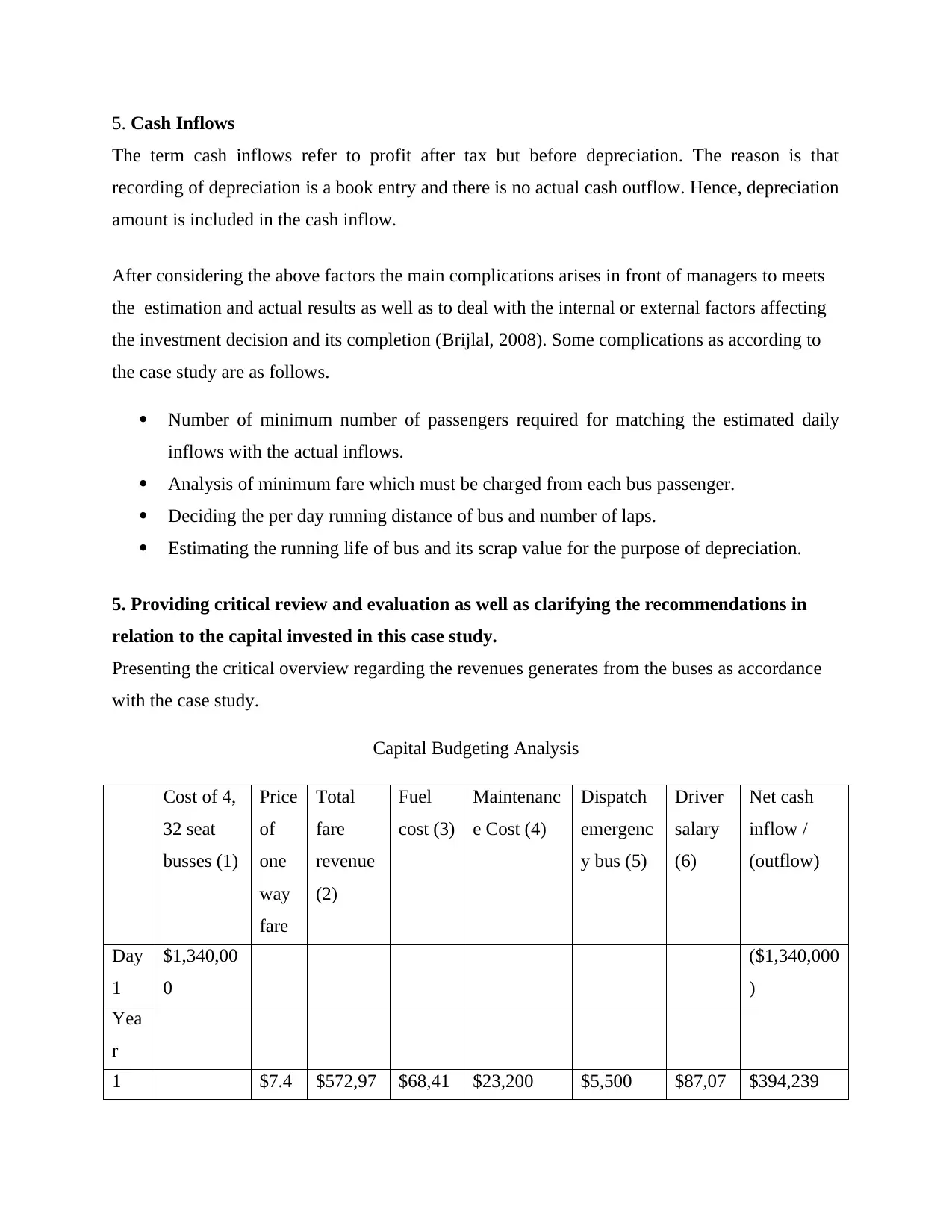
5. Cash Inflows
The term cash inflows refer to profit after tax but before depreciation. The reason is that
recording of depreciation is a book entry and there is no actual cash outflow. Hence, depreciation
amount is included in the cash inflow.
After considering the above factors the main complications arises in front of managers to meets
the estimation and actual results as well as to deal with the internal or external factors affecting
the investment decision and its completion (Brijlal, 2008). Some complications as according to
the case study are as follows.
Number of minimum number of passengers required for matching the estimated daily
inflows with the actual inflows.
Analysis of minimum fare which must be charged from each bus passenger.
Deciding the per day running distance of bus and number of laps.
Estimating the running life of bus and its scrap value for the purpose of depreciation.
5. Providing critical review and evaluation as well as clarifying the recommendations in
relation to the capital invested in this case study.
Presenting the critical overview regarding the revenues generates from the buses as accordance
with the case study.
Capital Budgeting Analysis
Cost of 4,
32 seat
busses (1)
Price
of
one
way
fare
Total
fare
revenue
(2)
Fuel
cost (3)
Maintenanc
e Cost (4)
Dispatch
emergenc
y bus (5)
Driver
salary
(6)
Net cash
inflow /
(outflow)
Day
1
$1,340,00
0
($1,340,000
)
Yea
r
1 $7.4 $572,97 $68,41 $23,200 $5,500 $87,07 $394,239
The term cash inflows refer to profit after tax but before depreciation. The reason is that
recording of depreciation is a book entry and there is no actual cash outflow. Hence, depreciation
amount is included in the cash inflow.
After considering the above factors the main complications arises in front of managers to meets
the estimation and actual results as well as to deal with the internal or external factors affecting
the investment decision and its completion (Brijlal, 2008). Some complications as according to
the case study are as follows.
Number of minimum number of passengers required for matching the estimated daily
inflows with the actual inflows.
Analysis of minimum fare which must be charged from each bus passenger.
Deciding the per day running distance of bus and number of laps.
Estimating the running life of bus and its scrap value for the purpose of depreciation.
5. Providing critical review and evaluation as well as clarifying the recommendations in
relation to the capital invested in this case study.
Presenting the critical overview regarding the revenues generates from the buses as accordance
with the case study.
Capital Budgeting Analysis
Cost of 4,
32 seat
busses (1)
Price
of
one
way
fare
Total
fare
revenue
(2)
Fuel
cost (3)
Maintenanc
e Cost (4)
Dispatch
emergenc
y bus (5)
Driver
salary
(6)
Net cash
inflow /
(outflow)
Day
1
$1,340,00
0
($1,340,000
)
Yea
r
1 $7.4 $572,97 $68,41 $23,200 $5,500 $87,07 $394,239
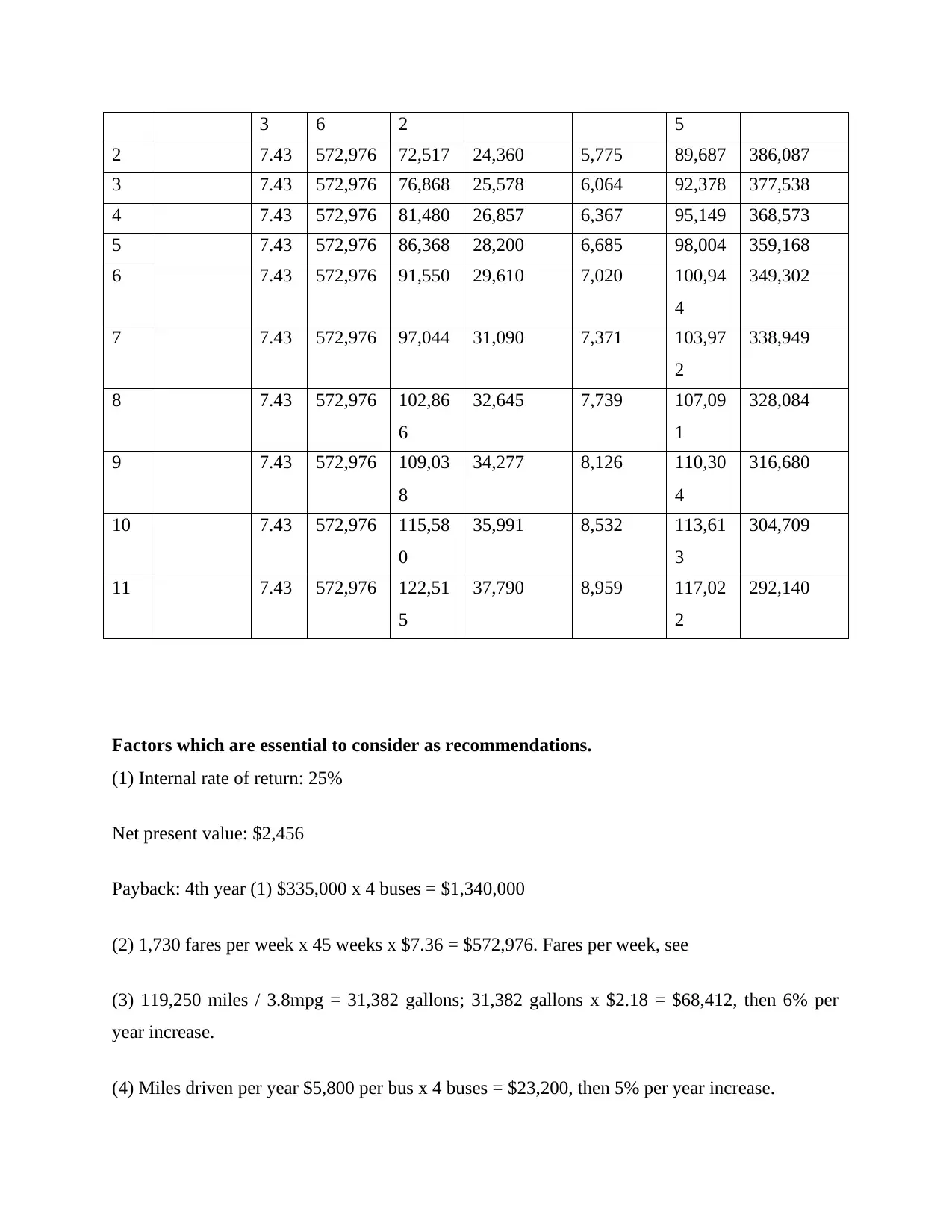
3 6 2 5
2 7.43 572,976 72,517 24,360 5,775 89,687 386,087
3 7.43 572,976 76,868 25,578 6,064 92,378 377,538
4 7.43 572,976 81,480 26,857 6,367 95,149 368,573
5 7.43 572,976 86,368 28,200 6,685 98,004 359,168
6 7.43 572,976 91,550 29,610 7,020 100,94
4
349,302
7 7.43 572,976 97,044 31,090 7,371 103,97
2
338,949
8 7.43 572,976 102,86
6
32,645 7,739 107,09
1
328,084
9 7.43 572,976 109,03
8
34,277 8,126 110,30
4
316,680
10 7.43 572,976 115,58
0
35,991 8,532 113,61
3
304,709
11 7.43 572,976 122,51
5
37,790 8,959 117,02
2
292,140
Factors which are essential to consider as recommendations.
(1) Internal rate of return: 25%
Net present value: $2,456
Payback: 4th year (1) $335,000 x 4 buses = $1,340,000
(2) 1,730 fares per week x 45 weeks x $7.36 = $572,976. Fares per week, see
(3) 119,250 miles / 3.8mpg = 31,382 gallons; 31,382 gallons x $2.18 = $68,412, then 6% per
year increase.
(4) Miles driven per year $5,800 per bus x 4 buses = $23,200, then 5% per year increase.
2 7.43 572,976 72,517 24,360 5,775 89,687 386,087
3 7.43 572,976 76,868 25,578 6,064 92,378 377,538
4 7.43 572,976 81,480 26,857 6,367 95,149 368,573
5 7.43 572,976 86,368 28,200 6,685 98,004 359,168
6 7.43 572,976 91,550 29,610 7,020 100,94
4
349,302
7 7.43 572,976 97,044 31,090 7,371 103,97
2
338,949
8 7.43 572,976 102,86
6
32,645 7,739 107,09
1
328,084
9 7.43 572,976 109,03
8
34,277 8,126 110,30
4
316,680
10 7.43 572,976 115,58
0
35,991 8,532 113,61
3
304,709
11 7.43 572,976 122,51
5
37,790 8,959 117,02
2
292,140
Factors which are essential to consider as recommendations.
(1) Internal rate of return: 25%
Net present value: $2,456
Payback: 4th year (1) $335,000 x 4 buses = $1,340,000
(2) 1,730 fares per week x 45 weeks x $7.36 = $572,976. Fares per week, see
(3) 119,250 miles / 3.8mpg = 31,382 gallons; 31,382 gallons x $2.18 = $68,412, then 6% per
year increase.
(4) Miles driven per year $5,800 per bus x 4 buses = $23,200, then 5% per year increase.
⊘ This is a preview!⊘
Do you want full access?
Subscribe today to unlock all pages.

Trusted by 1+ million students worldwide

(5) Breakdowns $500 per dispatch x 4 dispatches = $2,000; over capacity $350 per dispatch x 10
dispatches = $3,500;
total $2,000 + $3,500 = $5,500, then 5% per year increase.
(6) $36,500 salary + $21,550 benefits x 1 ½ drivers, then 3% per year increase.
Recommendations for the better implementation of desired investment plan accordance
with the case study.
The MART must increase the fair charges per passenger so, that the revenues and rate of
return increases.
The organization must render the appropriate compensation to driver as the driver’s
salary and maintenance affects the profitability.
Moreover, the entity must appoint a cleaner for the bus cleaning, this will helps in
attaining more satisfaction and helps attaining sustainability standards of investments.
CONCLUSION
On the basis of above case study, it is concluded that capital budgeting is crucial part
managerial activities. The capital budgeting process and its techniques plays a vital role deciding
the business entity's investment decisions. There are several factors like return on investment,
future earnings, allocation of funds for investments etc. which effects the investments decision
and are required to analyze critically with help of capital budgeting techniques.
dispatches = $3,500;
total $2,000 + $3,500 = $5,500, then 5% per year increase.
(6) $36,500 salary + $21,550 benefits x 1 ½ drivers, then 3% per year increase.
Recommendations for the better implementation of desired investment plan accordance
with the case study.
The MART must increase the fair charges per passenger so, that the revenues and rate of
return increases.
The organization must render the appropriate compensation to driver as the driver’s
salary and maintenance affects the profitability.
Moreover, the entity must appoint a cleaner for the bus cleaning, this will helps in
attaining more satisfaction and helps attaining sustainability standards of investments.
CONCLUSION
On the basis of above case study, it is concluded that capital budgeting is crucial part
managerial activities. The capital budgeting process and its techniques plays a vital role deciding
the business entity's investment decisions. There are several factors like return on investment,
future earnings, allocation of funds for investments etc. which effects the investments decision
and are required to analyze critically with help of capital budgeting techniques.
Paraphrase This Document
Need a fresh take? Get an instant paraphrase of this document with our AI Paraphraser
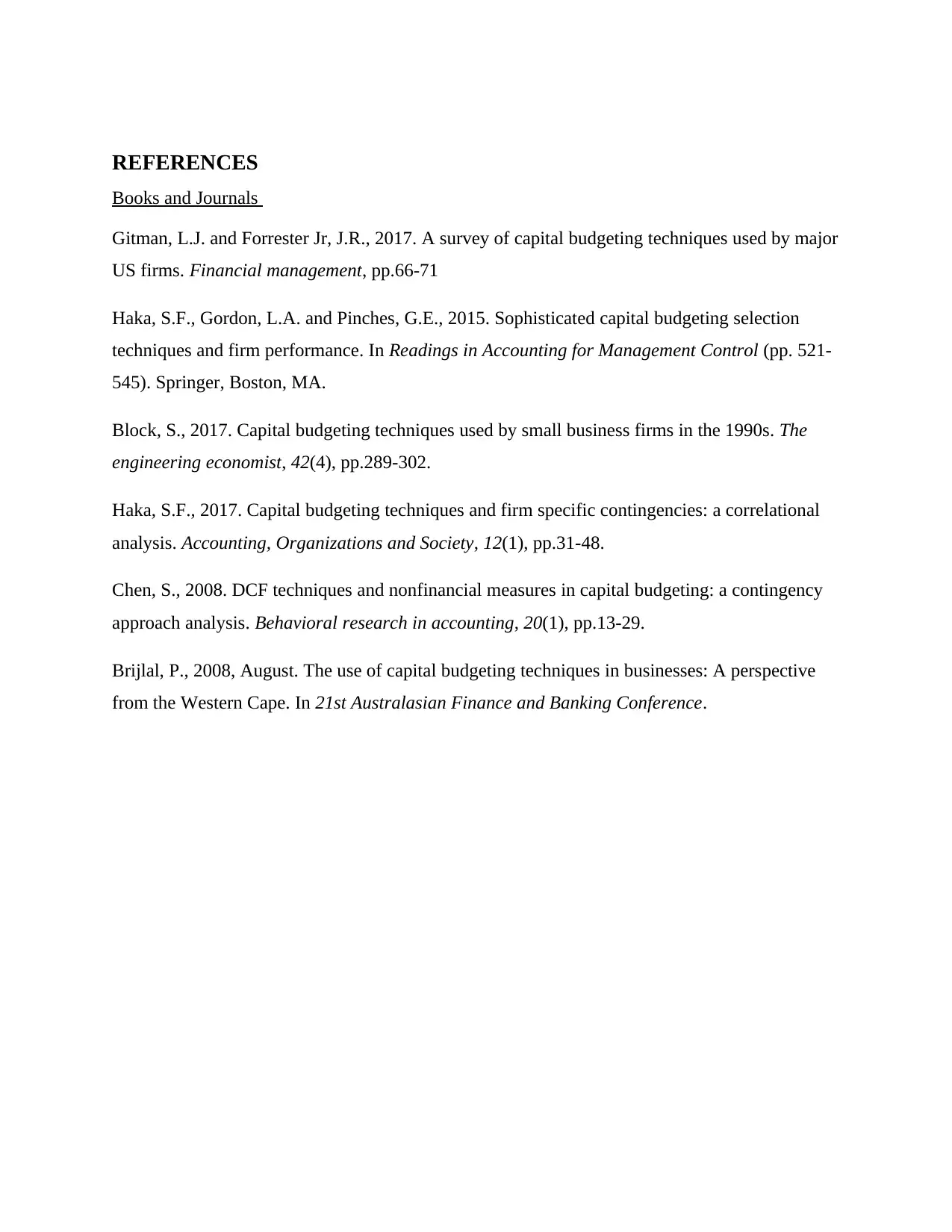
REFERENCES
Books and Journals
Gitman, L.J. and Forrester Jr, J.R., 2017. A survey of capital budgeting techniques used by major
US firms. Financial management, pp.66-71
Haka, S.F., Gordon, L.A. and Pinches, G.E., 2015. Sophisticated capital budgeting selection
techniques and firm performance. In Readings in Accounting for Management Control (pp. 521-
545). Springer, Boston, MA.
Block, S., 2017. Capital budgeting techniques used by small business firms in the 1990s. The
engineering economist, 42(4), pp.289-302.
Haka, S.F., 2017. Capital budgeting techniques and firm specific contingencies: a correlational
analysis. Accounting, Organizations and Society, 12(1), pp.31-48.
Chen, S., 2008. DCF techniques and nonfinancial measures in capital budgeting: a contingency
approach analysis. Behavioral research in accounting, 20(1), pp.13-29.
Brijlal, P., 2008, August. The use of capital budgeting techniques in businesses: A perspective
from the Western Cape. In 21st Australasian Finance and Banking Conference.
Books and Journals
Gitman, L.J. and Forrester Jr, J.R., 2017. A survey of capital budgeting techniques used by major
US firms. Financial management, pp.66-71
Haka, S.F., Gordon, L.A. and Pinches, G.E., 2015. Sophisticated capital budgeting selection
techniques and firm performance. In Readings in Accounting for Management Control (pp. 521-
545). Springer, Boston, MA.
Block, S., 2017. Capital budgeting techniques used by small business firms in the 1990s. The
engineering economist, 42(4), pp.289-302.
Haka, S.F., 2017. Capital budgeting techniques and firm specific contingencies: a correlational
analysis. Accounting, Organizations and Society, 12(1), pp.31-48.
Chen, S., 2008. DCF techniques and nonfinancial measures in capital budgeting: a contingency
approach analysis. Behavioral research in accounting, 20(1), pp.13-29.
Brijlal, P., 2008, August. The use of capital budgeting techniques in businesses: A perspective
from the Western Cape. In 21st Australasian Finance and Banking Conference.
1 out of 11
Related Documents
Your All-in-One AI-Powered Toolkit for Academic Success.
+13062052269
info@desklib.com
Available 24*7 on WhatsApp / Email
![[object Object]](/_next/static/media/star-bottom.7253800d.svg)
Unlock your academic potential
Copyright © 2020–2025 A2Z Services. All Rights Reserved. Developed and managed by ZUCOL.




